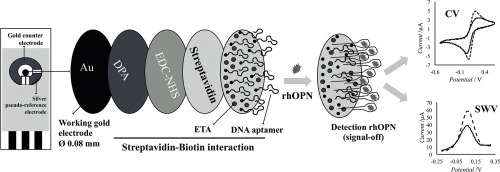当前位置:
X-MOL 学术
›
Anal. Chim. Acta
›
论文详情
Our official English website, www.x-mol.net, welcomes your
feedback! (Note: you will need to create a separate account there.)
Electrochemical aptasensor for human osteopontin detection using a DNA aptamer selected by SELEX
Analytica Chimica Acta ( IF 5.7 ) Pub Date : 2017-09-01 , DOI: 10.1016/j.aca.2017.07.071 Sofia G. Meirinho , Luís G. Dias , António M. Peres , Lígia R. Rodrigues
Analytica Chimica Acta ( IF 5.7 ) Pub Date : 2017-09-01 , DOI: 10.1016/j.aca.2017.07.071 Sofia G. Meirinho , Luís G. Dias , António M. Peres , Lígia R. Rodrigues

|
A DNA aptamer with affinity and specificity for human osteopontin (OPN), a potential breast cancer biomarker, was selected using the SELEX process, considering its homology rate and the stability of its secondary structures. This aptamer exhibited a satisfactory affinity towards OPN, showing dissociation constants lower than 2.5 nM. It was further used to develop a simple, label-free electrochemical aptasensor against OPN. The aptasensor showed good sensitivity towards OPN in standard solutions, being the square wave voltammetry (SWV), compared to the cyclic voltammetry, the most sensitive technique with detection and quantification limits of 1.4 ± 0.4 nM and 4.2 ± 1.1 nM, respectively. It showed good reproducibility and acceptable selectivity, exhibiting low signal interferences from other proteins, as thrombin, with 2.6-10 times lower current signals-off than for OPN. The aptasensor also successfully detected OPN in spiked synthetic human plasma. Using SWV, detection and quantification limits (1.3 ± 0.1 and 3.9 ± 0.4 nM) within the OPN plasma levels reported for patients with breast cancer (0.4-4.5 nM) or with metastatic or recurrent breast cancer (0.9-8.4 nM) were found. Moreover, preliminary assays, using a sample of human plasma, showed that the aptasensor and the standard ELISA method quantified similar OPN levels (2.2 ± 0.7 and 1.7 ± 0.1 nM, respectively). Thus, our aptasensor coupled with SWV represents a promising alternative for the detection of relevant breast cancer biomarkers.
中文翻译:

使用由 SELEX 选择的 DNA 适体的用于人骨桥蛋白检测的电化学适体传感器
考虑到其同源率和二级结构的稳定性,使用 SELEX 过程选择了对人骨桥蛋白 (OPN)(一种潜在的乳腺癌生物标志物)具有亲和力和特异性的 DNA 适体。该适体对 OPN 表现出令人满意的亲和力,解离常数低于 2.5 nM。它被进一步用于开发一种简单的、无标记的针对 OPN 的电化学适体传感器。与循环伏安法相比,适体传感器对标准溶液中的 OPN 表现出良好的灵敏度,即方波伏安法 (SWV),循环伏安法是检测和定量限分别为 1.4 ± 0.4 nM 和 4.2 ± 1.1 nM 的最灵敏技术。它显示出良好的重现性和可接受的选择性,表现出来自其他蛋白质(如凝血酶)的低信号干扰,2。电流信号关闭比 OPN 低 6-10 倍。适体传感器还成功检测到加标合成人血浆中的 OPN。使用 SWV,发现了针对乳腺癌 (0.4-4.5 nM) 或转移性或复发性乳腺癌 (0.9-8.4 nM) 患者报告的 OPN 血浆水平内的检测和定量限 (1.3 ± 0.1 和 3.9 ± 0.4 nM)。此外,使用人血浆样本进行的初步分析表明,适体传感器和标准 ELISA 方法量化了类似的 OPN 水平(分别为 2.2 ± 0.7 和 1.7 ± 0.1 nM)。因此,我们的适体传感器与 SWV 相结合代表了检测相关乳腺癌生物标志物的有前途的替代方案。在 OPN 血浆水平内发现了乳腺癌 (0.4-4.5 nM) 或转移性或复发性乳腺癌 (0.9-8.4 nM) 患者的血浆水平。此外,使用人血浆样本进行的初步分析表明,适体传感器和标准 ELISA 方法量化了类似的 OPN 水平(分别为 2.2 ± 0.7 和 1.7 ± 0.1 nM)。因此,我们的适体传感器与 SWV 相结合代表了检测相关乳腺癌生物标志物的有前途的替代方案。在 OPN 血浆水平内发现了乳腺癌 (0.4-4.5 nM) 或转移性或复发性乳腺癌 (0.9-8.4 nM) 患者的血浆水平。此外,使用人血浆样本进行的初步分析表明,适体传感器和标准 ELISA 方法量化了类似的 OPN 水平(分别为 2.2 ± 0.7 和 1.7 ± 0.1 nM)。因此,我们的适体传感器与 SWV 相结合代表了检测相关乳腺癌生物标志物的有前途的替代方案。
更新日期:2017-09-01
中文翻译:

使用由 SELEX 选择的 DNA 适体的用于人骨桥蛋白检测的电化学适体传感器
考虑到其同源率和二级结构的稳定性,使用 SELEX 过程选择了对人骨桥蛋白 (OPN)(一种潜在的乳腺癌生物标志物)具有亲和力和特异性的 DNA 适体。该适体对 OPN 表现出令人满意的亲和力,解离常数低于 2.5 nM。它被进一步用于开发一种简单的、无标记的针对 OPN 的电化学适体传感器。与循环伏安法相比,适体传感器对标准溶液中的 OPN 表现出良好的灵敏度,即方波伏安法 (SWV),循环伏安法是检测和定量限分别为 1.4 ± 0.4 nM 和 4.2 ± 1.1 nM 的最灵敏技术。它显示出良好的重现性和可接受的选择性,表现出来自其他蛋白质(如凝血酶)的低信号干扰,2。电流信号关闭比 OPN 低 6-10 倍。适体传感器还成功检测到加标合成人血浆中的 OPN。使用 SWV,发现了针对乳腺癌 (0.4-4.5 nM) 或转移性或复发性乳腺癌 (0.9-8.4 nM) 患者报告的 OPN 血浆水平内的检测和定量限 (1.3 ± 0.1 和 3.9 ± 0.4 nM)。此外,使用人血浆样本进行的初步分析表明,适体传感器和标准 ELISA 方法量化了类似的 OPN 水平(分别为 2.2 ± 0.7 和 1.7 ± 0.1 nM)。因此,我们的适体传感器与 SWV 相结合代表了检测相关乳腺癌生物标志物的有前途的替代方案。在 OPN 血浆水平内发现了乳腺癌 (0.4-4.5 nM) 或转移性或复发性乳腺癌 (0.9-8.4 nM) 患者的血浆水平。此外,使用人血浆样本进行的初步分析表明,适体传感器和标准 ELISA 方法量化了类似的 OPN 水平(分别为 2.2 ± 0.7 和 1.7 ± 0.1 nM)。因此,我们的适体传感器与 SWV 相结合代表了检测相关乳腺癌生物标志物的有前途的替代方案。在 OPN 血浆水平内发现了乳腺癌 (0.4-4.5 nM) 或转移性或复发性乳腺癌 (0.9-8.4 nM) 患者的血浆水平。此外,使用人血浆样本进行的初步分析表明,适体传感器和标准 ELISA 方法量化了类似的 OPN 水平(分别为 2.2 ± 0.7 和 1.7 ± 0.1 nM)。因此,我们的适体传感器与 SWV 相结合代表了检测相关乳腺癌生物标志物的有前途的替代方案。











































 京公网安备 11010802027423号
京公网安备 11010802027423号